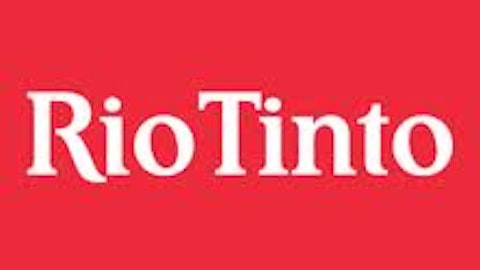
Business Snapshot
Rio Tinto is considered one of the largest mineral corporation in the world, with different product groups including aluminum, copper, diamonds, iron ore, etc. The majority of Rio Tinto’s earnings were generated from the iron ore segment, more than $12.85 billion, accounting for 82.6% of the total group underlying earnings in 2011. The second biggest earnings source was copper, with $1.93 billion in earnings, representing 12.4% of the total 2011 earnings. In the last 10 years, Rio Tinto has managed to generate consistently positive operating cash flow and free cash flow. The operating cash flow has increased from $2.72 billion in 2002 to more than $20 billion in 2011. The free cash flow has fluctuated in the range of $535 million to $13.69 billion for the last 10 years. Rio Tinto had quite a strong balance sheet. As of June 2012, it had nearly $55.68 billion in total stockholders’ equity, nearly $7.3 billion in cash, $1.77 billion in short-term debt and $19.4 billion in long-term debt. The debt/equity ratio was only 0.3x and the interest coverage was quite high at 27.6x.
Two Huge Bad Acquisitions
Rio Tinto would recognize $14 billion in non-cash impairment charge in fiscal 2012, including $3 billion relating to Mozambique Coal and $10 billion – $11 billion decrease in its aluminum assets’ carrying value. The company also expected several write-downs of $500 million. The total $14 billion impairment charges related to two bad acquisitions. The $3 billion write-down has nearly wiped out the total acquisition cost of $3.7 billion, which Rio Tinto has paid to acquire the coal assets in Mozambique. The $10-$11 billion charges has increased the total write-down on Alcan’s acquisition to nearly $30 billion, representing 80% of the total purchase price of $38.1 billion in 2007. Jan du Plessis, Rio Tinto’s chairman said:
“The Rio Tinto Board fully acknowledges that a write-down of this scale in relation to the relatively recent Mozambique acquisition is unacceptable. We are also deeply disappointed to have to take a further substantial write-down in our aluminum businesses, albeit in an industry that continues to experience significant adverse changes globally.”
In 2010, Rio Tinto’s net income was the highest in the last 10 years, at $14.3 billion. In 2011, it earned only $5.8 billion. The huge non-impairment charges might drag Rio Tinto’s full year 2012 earnings into negative figures.
Potential Near Term Price Drop?
At the current trading price of $55.85 per share, Rio Tinto is worth $103.15 billion in the market. The market is valuing Rio Tinto at 25.55x trailing P/E and 1.82x P/B. The $14 billion non-cash charges would be equal to 13.6% of the company’s total market capitalization. If we assumed that Rio Tinto is fairly valued in the market, I would expect the equivalent drop in its market price. Otherwise, Rio Tinto would look more expensive with the higher price/book valuation.
Compared to its peers, including BHP Billiton Limited (ADR) (NYSE:BHP) and Vale SA (ADR) (NYSE:VALE), Rio Tinto seemed to be the most expensive mining giant. BHP, with $76.87 per share, is worth $205.5 billion in the market. It is valued at only 13.33x trailing P/E. Vale’s share price is currently $20.02 per share, with a total market capitalization of $103.17 billion. The market is valuing Vale at 8.8x P/E. Currently, BHP and Rio Tinto are paying the same dividend yield of 2.9%, whereas Vale is paying 1.6%. Among the three, Rio Tinto had the highest amount of goodwill and intangible assets at $16.3 billion on its balance sheet. BHP and Vale were much more conservative with relatively smaller goodwill and intangible asset amounts. BHP had more than $1.6 billion in intangible assets and no goodwill, while Vale had nearly $3 billion in goodwill and $1 billion in intangible assets. Thus, the likelihood of write-down for both BHP and Vale were much smaller than for Rio Tinto.
My Foolish Take
Investors should always remember two things. First, the values of mineral companies are moving closely with the commodity market prices. Second, the giant and expensive acquisition would turn sour for the company’s market price and its shareholders in the long run. Be careful when the big becomes bigger but not more efficient.
The article Two Bad Acquisitions With a Huge Writedown originally appeared on Fool.com and is written by Anh HOANG.
Copyright © 1995 – 2013 The Motley Fool, LLC. All rights reserved. The Motley Fool has a disclosure policy.





